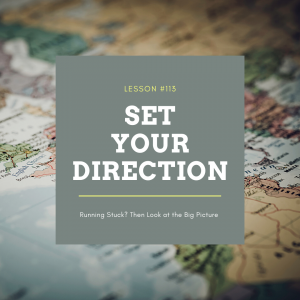Lesson 113 – Running Stuck? Set Your Direction
 The Long Story Short: If you’re struggling to write your next scene, look at the bigger picture.
The Long Story Short: If you’re struggling to write your next scene, look at the bigger picture.
The Short Story Long: For years, I was a ‘pantser’. That is, I was a writer who wrote by the seat of her pants with no plan in mind. I’d start with my characters and setting, but I didn’t know what direction the story would take. In fact, I called this the, “Playing with Barbie Dolls” style of writing since the story relied so heavily on its characters. My books were completely organic. However, my lack of vision meant I spent a lot of time staring at a blank screen, wondering what was going to happen next.
After years of struggling, I finally got smart and realized that I needed to build a framework before I started writing. I’d always had a prejudice against plotters – writers who wrote an outline from the very beginning. I believed that outlining would stifle my creativity. I suppose we’re all languishing under our own preconceived ideas of what a writer should and shouldn’t do. However, once I got over this mindset and started to outline, my writing flowed more smoothly and I was able to write faster.
Right now, when I start a new project I use Plottr. I have the app on my phone, so I can use it any time I’d like, even while waiting in line at the store. The Plottr phone app is pretty basic – mostly a note taking app with a few nice features especially for writers – but I like how I can build stories from the ground up. Having a direction isn’t as stifling as I’d worried it would be, and it’s given me the freedom to focus on developing each chapter rather than stressing on what to write next.
Here’s a snippet from my current work in progress:

Once again, I’ve started with settings but this time I know exactly how the settings are going to interact with the story. Instead of simply being background, the settings have become integral parts of the story.
The nice thing about Plottr is that you can start wherever you’d like and build from there. This means that I can also start with characters (and add their traits and personalities). From there, I can move on to actual plot points and – most importantly – an ending.
Ever since I’ve started plotting, I no longer feel like I’m writing in the dark. If you haven’t tried adding structure to your story, or if you’ve got a terrific idea but are struggling with how to write a story about it, then I highly recommend using an outline.
The post Lesson 113 – Running Stuck? Set Your Direction appeared first on Writing2x.



